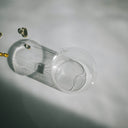Hairs play an essential role in refining the outer look of a person. Imagining oneself without hair sounds like a horrible idea. Are you currently going through the phase where you are afraid of being bald?
According to a study, men's risk of going bald rises as they age. Men aged 18 to 29 experience 16% hair loss, while those aged 40 to 49 experience 53% hair loss.
No one goes bald overnight. The first noticeable symptom of going hairless is hair thinning. A receding hairline follows hair thinning. It might be possible that the one you are taking as the receding hairline turns out to be the maturing hairline.
Table of content
What is a mature hairline?
A mature hairline is a natural change in the hairline that occurs as men age, usually in their late teens to early twenties. It is characterized by a slight upward shift of the hairline, particularly at the temples, resulting in a more defined and adult appearance. This process is normal and not a cause for concern, as it is not associated with hair loss or male pattern baldness.
As your leading source for hair health information over the past 4 years, we never compromise on accuracy. When it comes to your health, you deserve information you can truly rely on - and earning your trust is our top priority.
Here's how Scandinavian Biolabs ensures every piece of content meets the highest standards of accuracy and integrity:
- Credentialed Experts: Our reviewers are actively practicing doctors and medical researchers
- Stringent Reviews: Content undergoes rigorous editing by subject specialists and review by a practicing doctor.
- Evidence-Based: We rely on well-established research from trusted scientific sources like peer-reviewed journals and health authorities.
- Full Transparency: Our editorial standards, writer credentials, reviewer credentials, correction process, and funding are all publicly documented.
- Independent Voice: While we do promote products, we operate in a vacuum to business operations. Our main goal is just an unwavering commitment to providing medically-sound guidance.
You can count on Scandinavian Biolabs to consistently deliver the trustworthy health information you deserve. Read our Editorial Standards.
What is a receding hairline?
A receding hairline is a common sign of male pattern baldness, a hereditary condition affecting hair growth. It is characterized by a progressive loss of hair, starting at the temples and the forehead, which eventually leads to a characteristic "M" or "U" shape. Unlike a mature hairline, a receding hairline is a result of hair thinning and can be a cause for concern for those experiencing it.
Mature hairline vs receding hairline comparison table
| Feature | Mature Hairline | Receding Hairline |
|---|---|---|
| Definition | A natural change in the hairline as men age, usually in late teens to early twenties. | A progressive loss of hair due to male pattern baldness, starting at the temples and forehead. |
| Cause | Part of the normal aging process. | Often caused by genetics, hormones (DHT), and other factors such as stress and poor nutrition. |
| Appearance | Slight upward shift of the hairline, particularly at the temples, resulting in a more defined shape. | Hair loss starting at the temples and forehead, eventually forming an "M" or "U" shape. |
| Association with Hair Loss | Not associated with hair loss or male pattern baldness. | Directly associated with hair loss and male pattern baldness. |
| Treatment/Intervention | Usually, no intervention is needed as it is a natural part of aging. | Various treatment options, including medications (minoxidil, finasteride), laser therapy, hair transplant surgery, and natural hair care routines such as Scandinavian Biolabs Hair Growth Routine for Men. |
How to tell if your hairline is maturing or receding?
To determine whether your hairline is maturing or receding, observe the pattern and extent of hair loss.
A maturing hairline typically involves a slight upward shift of the hairline with a more defined shape, whereas a receding hairline involves more significant hair loss, thinning, and a changing shape, often forming an "M" or "U" pattern.
Appearance
A maturing hairline does not make a larger change to the original position of your hairline. So, you suffer from receding hairline if your hair has moved back more than 2 cm. Hairline receding also makes you look older than your original age.
Age
The age consideration of both hairlines is almost the same. But if you notice excessive hair shedding in your late teens and early 20s, you have a receding hairline. On the other hand, if your entire hairline moves back later in life, it is a mature hairline.
Family history
According to a study on the baldness gene in twins, genetics are responsible for 80% of male pattern baldness. If your hairline is receding in a pattern similar to your ancestors', you have a receding hairline.
What should you do if your hairline is maturing?
If your hairline is maturing, there's generally no need for intervention, as it is a normal part of the aging process.
You can continue to maintain healthy hair care practices to ensure the overall health of your hair.
This includes using gentle hair products, avoiding tight hairstyles or excessive heat, and eating a balanced diet.
What should you do if your hairline is receding?
If your hairline is receding, consider taking the following steps:
Consult a healthcare professional
Speak with a dermatologist or hair loss specialist to discuss your concerns and determine the best course of action.
Explore treatment options
Depending on the severity of the hair loss, your healthcare professional may recommend treatments like minoxidil, finasteride, laser therapy, or hair transplant surgery.
Maintain a healthy lifestyle
A balanced diet, regular exercise, stress management, and proper sleep can support hair health and potentially slow down hair loss.
Be gentle with your hair
Use a wide-toothed comb, avoid tight hairstyles or excessive heat, and choose gentle hair care products to minimize additional stress on your hair.
How to stop a receding hairline?
To stop a receding hairline, consider various treatment options, such as using the Scandinavian Biolabs Hair Growth Routine for Men, which is a naturally-derived, scientifically-backed three-step hair care routine. Other options include over-the-counter treatments like minoxidil (Rogaine), prescription medications such as finasteride (Propecia), or low-level laser therapy (LLLT) using at-home laser devices.
It's important to consult a healthcare professional for personalized advice and weigh the pros and cons of each treatment before making a decision.
1. Scandinavian Biolabs Hair Growth Routine for Men

This three-step routine consists of the Hair Strength Shampoo, Hair Recovery Conditioner, and Hair Growth Serum, all formulated with the unique, scientifically-backed Bio-Pilixin® formula.
By incorporating this routine into your daily hair care regimen, you can potentially achieve noticeable improvements in hair growth, reduced hair loss, and strengthened hair.
Notably, Scandinavian Biolabs conducted a 150-day clinical study, and 93% of the participants experienced reduced hair loss, while 73% saw an increase in hair growth.
2. Over-the-counter treatments
Minoxidil (Rogaine) is an FDA-approved topical treatment that can be applied to the scalp to help slow hair loss and stimulate new hair growth. It's essential to use this treatment consistently for optimal results.
3. Prescription medications
Finasteride (Propecia) is an FDA-approved oral medication that blocks the conversion of testosterone to dihydrotestosterone (DHT), a hormone associated with hair loss. Consult your healthcare provider to determine if this treatment is appropriate for you.
4. Laser therapy
Low-level laser therapy (LLLT) has been shown to stimulate hair growth by increasing blood flow and cellular activity in the scalp. At-home laser devices, such as combs, caps, or helmets, can be used consistently to achieve results.
How to prevent your hairline from receding?
While it's not always possible to prevent a receding hairline, especially if it's due to genetics, there are steps you can take to reduce the risk or slow its progression:
Maintain a healthy lifestyle
Eat a balanced diet rich in vitamins and minerals, exercise regularly, and get enough sleep.
Avoid tight hairstyles
Styles that pull on the hair, like tight ponytails or braids, can cause traction alopecia, which may contribute to a receding hairline.
Be gentle when styling
Use a wide-toothed comb and avoid excessive heat or harsh chemicals when styling your hair.
Manage stress
High stress levels can contribute to hair loss, so engage in stress-reducing activities such as meditation, exercise, or yoga.
Science on mature hairline vs. receding hairline
Mature hairline and receding hairline are two distinct conditions affecting the hairline in men.
A mature hairline is a natural progression as men age, typically occurring in late teens to early twenties.
Research indicates that a mature hairline is not associated with hair loss or male pattern baldness and is considered a normal part of aging.
On the other hand, a receding hairline is often a sign of male pattern baldness, a hereditary condition that leads to progressive hair loss.
Various studies have been conducted to understand the causes, progression, and treatment options for receding hairlines, including the role of hormones, genetics, and lifestyle factors.
Conclusion
A mature hairline and a receding hairline are two types of hair loss. A mature hairline is a normal part of the aging process, while a receding hairline is an early sign of male pattern baldness.
The best way to stop further receding is to eat well, live a healthy life, and see a doctor when necessary. With the proper care and treatment, both male and female pattern baldness can be treated successfully.
In the end, it is important to know the difference between a mature hairline and a receding hairline in order to decide what to do about hair loss.
Read more:








